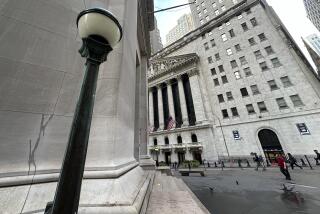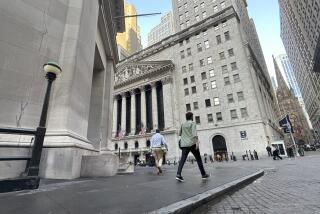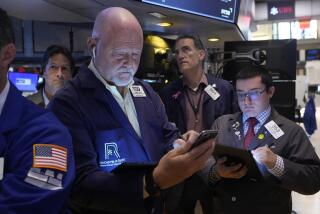Market Stages Strong Rally for 4th Gain in Row
NEW YORK — As Wall Street’s bloody October finally drew to a close, the stock market staged another broad rally Friday in a session featuring extremely heavy trading, little volatility and the fourth daily gain in a row for the Dow Jones industrial average.
U.S. stocks benefited both from their own powerful rally on Thursday and from a huge overnight surge in overseas stock prices. The Tokyo Stock Exchange’s best-known index, the 225-stock Nikkei average, romped to its third-largest single-day point gain as the dollar stabilized on foreign exchange markets. Prices also were sharply higher in London and moderately higher in Hong Kong.
Despite a report that the government’s index of leading economic indicators slipped 0.1% in September, the Dow Jones industrial average gained 55.20 points Friday to close at 1,993.53.
But even as investors were buying stocks at a torrid pace Friday and behaving as if the worst stock market crisis since the Great Depression were over, some institutions wandered back to the sidelines, and market analysts and traders who had been exuberant just the day before suddenly turned cautious.
Lurking behind the market’s unexpected aplomb, some now believe, is more instability and possibly even a replay of the panic-stricken days surrounding the Oct. 19 crash. On that day, the Dow Jones index of 30 blue-chip stocks lost an unprecedented 508 points, or 22.6% of its value.
‘Too Excited’
“Too many people are getting too excited too quickly,” said a “very concerned” Eugene D. Peroni, a technical analyst for the Philadelphia investment firm Janney Montgomery Scott. “We were buying aggressively on Wednesday, but we’re back on the sidelines now.”
“Gains will be much harder to come by next week,” predicted Jerry Helzner, a market strategist for Butcher & Singer, a Philadelphia investment firm. “I’m afraid people are going to find that this market is still treacherous and they were far too exuberant Friday.”
The pundits are spooked by two things: overly aggressive buying for a market that has just stumbled through a terrifying month, and investors’ fixation on the current budget negotiations between the White House and Congress.
Another Crash Feared
If Washington compromises on a deficit reduction package that proves unacceptable to investors, some analysts fear that the financial markets could come crashing down again. Reagan Administration and congressional officials plan to meet again today to try to resolve their differences.
“This market is still very sensitive, and if there is more turmoil and finger-pointing in Washington instead of strong action, I hate to think what might happen,” said Robert H. Stovall, president of Stovall-Twenty First Advisers in New York.
Helzner found Friday’s aggressive buying patterns equally disturbing.
“The steady driving rally on Thursday really looked good. But as soon as the market opened on Friday, there were signs of sloppiness. There were way too many people who really thought Thursday was proof that we had seen the worst,” Helzner said.
Flood of Small Orders
In the first hour of Friday’s session on the New York Stock Exchange, traders were inundated with buy orders as individual investors followed institutions’ lead. Burdened with so many small orders, the tape could not keep up with the trades.
“The tape was back to being late, some stocks were up an incredible $3 to $5 a share right off, and almost immediately the shrewd institutional investors pulled out,” Helzner said. “They don’t like to chase rallies.”
Although the pace slowed toward the end of the busy session, volume still hit 303.36 million shares, up from Thursday’s 258.14 million shares. It was the Big Board’s seventh-busiest day even though the exchange closed two hours early, as it has for a week.
More Short Hours
Abbreviated trading hours will continue next week as U.S. stock exchanges strive to dampen volatility and help the brokerage firms clear up the mountain of paper work from the extraordinary trading levels of the last 10 sessions. Before the hours were cut back, volume was running two to three times its usual pace.
The NYSE, American Stock Exchange and over-the-counter markets will close at 2:30 p.m. EST Monday through Wednesday and at 3 p.m. on Thursday and Friday. NYSE officials said they hope to resume a normal 6 1/2-hour trading day on Nov. 9.
Despite the overwhelmingly bearish views of analysts, not all was gloom and doom Friday. By every market measure, this was a week of healing.
The Dow’s 55.20-point gain stretched the closely watched index’s winning streak to four consecutive sessions, as it more than recovered its 156.83-point loss from last Monday.
Down Over 600 in Month
The gauge of blue-chip stocks surged almost 80 points in early trading and then drifted in a 20-point range before finishing the day at 1,993.53. That is higher than it has been in seven trading days although still more than 250 points shy of its 2,246.74 level before the Oct. 19 crash and more than 600 points lower than it started the month.
Other broader market measures also added to their gains. The Standard & Poor’s 500-stock index was 1.4% higher for the week after rising 7.02 points to close at 251.79 Friday, for its third consecutive daily gain. The NYSE composite index finished the week 1.2% higher after a 4.52-point increase to close at 140.80. And there were seven winning NYSE issues for every one that lost money.
Smaller stocks also enjoyed renewed buying interest Friday. But they were so severely punished early this week that they generally closed well below their levels of last Friday. The Amex index rose 18.06 points to close at 260.36, and the NASDAQ index rose 16.25 points to close at 323.30.
Up 3.3% in Tokyo
In Tokyo, the Nikkei average of 225 stocks climbed 731.15 points, or 3.3%, to close at 22,765.04. And in London, the Financial Times index of 100 shares was up 67.8 points, or about 4%, to close at 1,749.8.
Wall Street analysts also were heartened by the latest sale of a prized NYSE seat. One sold Friday for $800,000, a $50,000 increase from the last sale, just two days earlier.
Sensitive though traders say this market still is, it was largely unaffected by the British government’s decision to proceed Friday with its $12-billion offering of British Petroleum shares--albeit with safeguards to keep the stock price from sinking too low and dragging down world financial markets with it. BP shares sold in the United States ended the session at $17.25, well above the $14.40-a-share price guaranteed by the Bank of England.
Stock prices of the U.S. companies underwriting this controversial offering--Morgan Stanley & Co., Salomon Bros. and Shearson Lehman Bros.--also surged.
Institutions Back
The return of institutional buyers, while timid, also was encouraging to analysts scouting around for signs of renewed stability.
“I think they have already started to get their feet wet, and they may even be in up to their ankles by now,” said Trude Latimer, a market analyst at Josephthal & Co. in New York.
More to Read
Inside the business of entertainment
The Wide Shot brings you news, analysis and insights on everything from streaming wars to production — and what it all means for the future.
You may occasionally receive promotional content from the Los Angeles Times.










